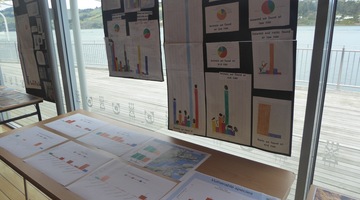Evans Bay Intermediate Principal Wendy Esera celebrates how teacher Ashleigh Grant has engaged her students in successful science enquiry. Educator Stephen Williams shares Science Learning Hub resources during the whole-staff discussion planning a unit on climate change.
The flexibility of Science Learning Hub resources is seen as key to building teachers’ confidence to develop their own science knowledge and engage their students with science.
Find out more about The ocean in action and The ocean conveyor belt video that Stephen talks about.
This video shows footage from the legacy Science Learning Hub, however all the conent referenced is still available on our new-look Science Learning Hub site.
Transcript
ASHLEIGH GRANT
So as a beginning teacher, when you’re given a unit, it’s always hard to figure out, well, where do I start? And having Stephen Williams come in with a PowerPoint for me was fantastic.
WENDY ESERA
She is a young new teacher, and yet the way that she is running her classroom is just lovely. Her classroom is a place of enquiry, and she’s a learner too, and that comes through in letting children take the learning to where their enquiry is going.
ASHLEIGH GRANT
So, volunteers please.
WENDY ESERA
It’s getting a teacher out from where everything is very planned and organised to that point of where it’s like we’ll see where it takes us.
ASHLEIGH GRANT
We discovered that the children had difficulty with fire and TV, as they thought both things were living, so we scaled it down to my next learning step being, well, how do we know what a living thing is?
STEPHEN WILLIAMS
When she started to talk about some of the issues that she had, I could see that some of the other teachers were thinking we’ve got some similar issues as well, and then there was a lot of rich discussion of how some of those issues might be resolved or how they might adapt it to their teaching style.
STEPHEN WILLIAMS
The great thing with science is sometimes there aren’t answers there. This is why they’re trying to find out more.
TEACHER
… generate more questions.
WENDY ESERA
There was just that, oh look, what are you doing next term? Well, we’re actually looking at climate change. Oh, we’ve got a resource that you can use. Oh, have you? Then showing us that resource.
STEPHEN WILLIAMS
The angle that we took is that New Zealand is surrounded by water. The water does influence our climate, so what is driving the temperature changes in the water, because that is eventually going to affect us. Climate change is going to raise the global temperatures, but how is it going to affect the water around New Zealand?
So we explored oceans in action, which looks at the ocean currents, and I’ve started that off by looking at some footage from NASA of ocean currents around the world speeded up over time. I was stunned when I saw some of the videos, and they said it takes 1,000–2,000 years for the water to travel from the Norwegian coast to New Zealand. When I’ve shown that video clip from the Hub, that’s really engaged a lot of teachers. It also starts to create some big questions, because you think, gosh, if it’s taken 1–2,000 thousand years for this water to move, how long is it going to take before some of our actions are going to affect future generations?
WENDY ESERA
Half the staff, the next day at morning tea, were all going, I learnt a heap myself. We’d like to know more about that. Well, I think this unit about climate change will be a very successful one.
ASHLEIGH GRANT
I have really enjoyed the lesson that we’ve been doing here and the way it has just flowed, coming from something and leading into the other. And having the discussion at the staff meeting regarding climate change and being provided with a starting point and the resources that are available to us on the Science Learning Hub, I feel confident, and I’m actually looking forward to it.
WENDY ESERA
The more resources, I believe too, that teachers have, the more confident teachers are to teach something. I think, with a teacher, fear of teaching anything is more about your own confidence in it, so looking for exciting, very user-friendly resources which teachers can connect with too and feel comfortable with because somebody is helping guide them and also motivate them.
The feedback that we got from children was giving us a clear message: they love science. They want to be doing science. And so I believe that the achievement in terms of that unit will be high as well, because where there’s high levels of interest, there’s high levels of engagement, and if there’s high levels of engagement, then there’s great learning outcomes happening.
Acknowledgements
Ashleigh Grant
Wendy Esera
Stephen Williams
Evans Bay Intermediate School


